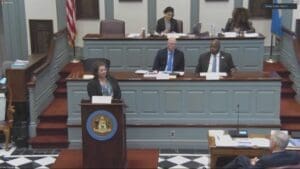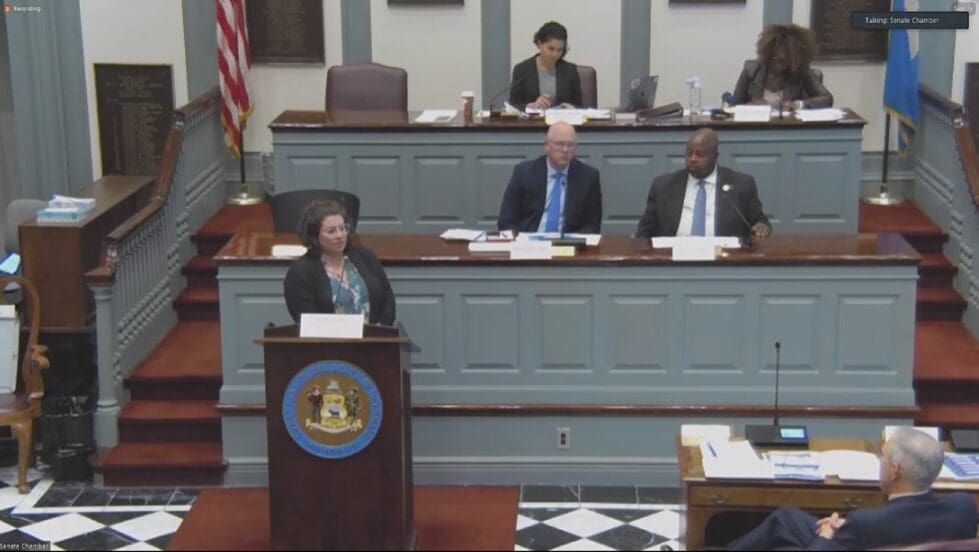

Rachel Stucker of Housing Alliance Delaware answers a question from a legislator after testifying during a joint hearing on housing and homelessness.
A joint legislative hearing held by Delaware Senate and Housing committees Wednesday started picking threads out of the tangled wad of factors affecting affordable housing and homelessness in Delaware.
The convening of the joint session was clearly a shot across the bow of the state political ship and a forerunner to more state, local and community action on the topics.
Among other things, the 20 members of the Senate Housing & Land Use Committee and the House Housing Committee heard:
- The last time the state convened a task force or group to look at the statewide problem was before 2017, and maybe as far back as 2007, said Dr. Stephen Metraux, director of the University of Delaware’s Center for Community Research & Service. It’s time for the state and the stakeholders to reconvene, look at research and all try to get on the same page instead of going in different directions.
- The pandemic showed stakeholders that there were many more homeless than the state realized when people surviving in the shadows came forward for help as COVID shut or hindered services. Some homeless have faded away again.
- At the same time, inflation soaring last year — and largely blamed on federal COVID 19 handouts — sent housing and rental costs soaring. Rental prices alone rose 40% in recent years. And the state’s move to raise minimum wage to $15 an hour by Jan. 1, 2026, will not help with that level of price hikes.
- Ideally, a family pays 30% or less of its income toward housing costs. However, in Wilmington, the median household income is $50,000. That means the household rent should be $1,250 or less per month and rents at the level are difficult to find for small spaces, much less a two-bedroom apartment.
- A lot of interest was expressed in government legislation or programs that might create a housing trust fund giving developers incentive to help create duplex, townhouse and other spaces that are more affordable to rent and buy. Most new home construction is single family detached homes, which are also the most expensive to buy and run.
- A few people suggested programs that set aside certain space for affordable houses for workers near the jobs and schools they need to be near, but acknowledged that zoning is usually a county or town matter.
- A lot of the money supporting people who need emergency shelter through hotel vouchers and more comes from the federal government, and there’s so many needy people — especially as the weather turns cold for winter — that few beds are available, even with a voucher.
- Those most at risk for homelessness include Black individuals and families; immigrant families; households with disabilities; and single parent households. Domestic abuse also is a large factor in causing homelessness.
A look at housing
Four groups who focus on housing and homelessness, clearly with an eye toward finding ways to join forces, establish connected community groups and pass more legislation related to the topics, talked about recent studies:
- Sequoia Rent, chief of the Bureau of Health Equity with the Department of Health and Social Services, who talked about data in its Delaware State Health Needs Assessment survey.
- Metraux hit the highlights of his 2023 report “Homelessness In Delaware: An Assessment.”
- Rachel Stucker of Housing Alliance Delaware summarized that agency’s 2023 Point In Time Count.
- Caitlin Del Collo of the Delaware State Housing Authority reviewed findings of its 2023 Delaware Housing Needs Assessment
RELATED STORY: Hope Center plans to face budget questions with facts
The speakers all agreed that homelessness had gotten worse in the last five years, spiking at the end of 2022, and that affordable housing continues to be a major issue for lower-income working families as inflation and rising prices have caused soaring costs to buy a house or rent a space.
Senate Majority Whip Sen. Elizabeth “Tizzy” Lockman, chair of the Senate Housing & Land Use Committee. noted that some legislation passed in last year’s session of the Delaware General Assembly was designed to help, and that legislation that was not passed will be back next year.
The Delaware General Assembly convenes Jan. 9.


Betsy Price is a Wilmington freelance writer who has 40 years of experience, including 15 at The News Journal in Delaware.
Share this Post



